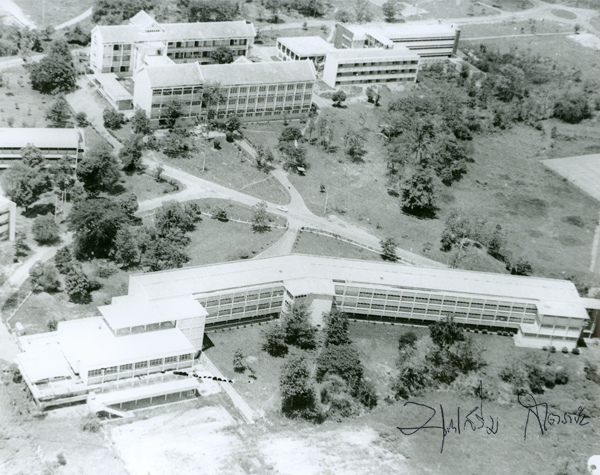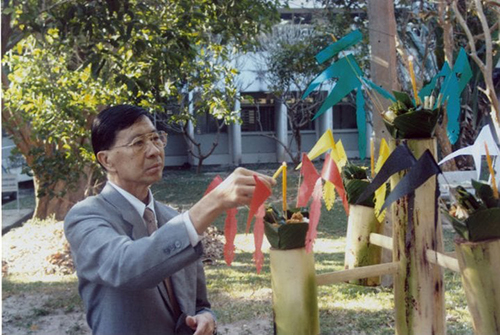May 18, 1961, at 3:45 p.m.
“Ruen Derm” or “The Original House”, is a small one-storey wooden house, built at the foothills of Doi Suthep for the single purpose of supporting the upcoming grand project that would be Chiang Mai University. The detail engraved on the wooden sign above the stairs to the old house read “Preparation for the establishment of Chiang Mai University started at this place on May 18, 1961, at 3:45 p.m.”.
The message of intention and the time recorded on this sign marks a vital milestone of an action. Chiang Mai University was born on a vast piece of land on which the Original House was erected as its first building; as a workplace to prepare for the establishment of the university. The purchasing of land, the planning of the utilisation of the space, the preparation of personnel for the university…they were all first done here.
The Implementation Committee which established Chiang Mai University was led by Professor M.L. Pin Malakul, Minister of Education at that time. He had chosen the area at the foothills of Doi Suthep to be the location for one significant reason: the distinctive features of this terrain which included both hills and lowlands. Another reason was the size of the land was large enough, according to the suggestion from Dr. Paul W. Seagers, a specialist in institutional planning from Indiana University, at least 400 rai of land was required to build a university.
There were approximately 579 rai and 68 square wah of land already in-hand from procurement and expropriation when the university was first established. This included orchards, kapok orchards, rice fields, forests, and creeks. The next vital task which followed was to appropriately and carefully plan and determine the utilisation of the area, taking both beauty and functional requirements into consideration. Professor M.L. Pin Malakul had expressed his intention in planning the area of Chiang Mai University in a poem; “Remarkably magnificent nature / Will enhance the beauty further.”


Committee for the establishment of Chiang Mai University led by Professor M.L. Pin MalakulExploring the area for building Chiang Mai University
Establishing Chiang Mai University was a challenging task, requiring both knowledge and imagination to transform a wild land into an educational institution, equipped with buildings that blended in with the beautiful landscape. Dr. Paul W. Seagers had travelled to consult on the planning and recommended plans to the architects on many occasions. After that, the architects responsible for the design of each building would choose the location of their buildings on the campus with the condition that the buildings would be built on higher land. Therefore, the first buildings of Chiang Mai University were all located on the foothills, blending the structures into the natural surroundings.
The buildings in the early days of Chiang Mai University were set to be in the front zone of the university. The buildings built in 1963 were the Office of the President, the Chemistry Building 1, the College Building 1 (Faculty of Political Science at present), and the Dharma Pavilion. In 1964 the College Building 2 (Currently Ang Kaew Dormitory) and the Faculty of Humanities, Student Relations Centre were built.
The building that remains in the memories of the first generation of CMU students in 1964 and is known as the first building of Chiang Mai University, Chemistry Building 1, was designed by architect Saman Wasuwat
 An aerial photograph of Chiang Mai University in 1970
Above is Chemistry Building 1, below is College Building 1 (Photo by Boonserm Satrabhaya).
An aerial photograph of Chiang Mai University in 1970
Above is Chemistry Building 1, below is College Building 1 (Photo by Boonserm Satrabhaya).
College Building 2 or the current Ang Kaew dormitory
 Science faculty building
Science faculty building
From the beginning of its operations in 1961 until Chiang Mai University opened its door to students on the first day of the first semester of the university on June 18th, 1964, the campus went through great transformations. The day the university opened, its campus was ready. There were reservoirs, roads, buildings, dormitories, water, electricity, water supply, and various utilities that were ready to accommodate students and personnel. In 1964 “Chiang Mai University” became the first regional university in Thailand.

Chiang Mai University from above Ang Kaew
(Photo from Chiang Mai Memories page)
Since the beginning, Chiang Mai University has progressed rapidly in all aspects, including the expansion of various faculties that now include multiple modern buildings. Nevertheless, “Ruen Derm”, a single-story wooden house, still remains – peacefully and simply in the corner of the Faculty of Humanities.
Another pivotal time for the Original House was in 1978 when Professor Dr. Udom Rungruengsri proposed to the Faculty of Humanities that they repair the house and use it as the Lanna Arts and Culture Promotion Unit. The Original House was also the place in which the Lanna Language and Literature Department graduate programme was established in 1986. This initiative was set up by the first group of teachers in the Lanna Language and Literature Department, namely Professor Dr. Udom Rungruengsri, Associate Professor Dr. Phichit Akkhanit, Assistant Professor Dr. Likhit Likhittanon, Assistant Professor Bampen Rawin and Professor Dr. Harald Hundius who used the Original House as a workplace and organised various activities related to the Lanna Language and Literature courses. Since then, the Original House has seen the creation of Lanna scholars, whom, amongst them, have built up a body of knowledge that tremendously contributes to the study of Lanna literature, such as the Lanna-Thai Dictionary, Mae Fah Luang Version, the Northern Thai Cultural Encyclopedia, etc.
 Professor Dr. Udom Rungruengsri at the merit making ceremony of Ruen Derm
Professor Dr. Udom Rungruengsri at the merit making ceremony of Ruen Derm
The Lanna work of Ruen Derm continued for decades until 2011 when a number of Lanna teachers passed away. This wooden house was brought back to life again in 2021, the year the house turned 60 years old. It was the time that Assistant Professor Dr. Piyapat Jarusawat from the Department of Library and Information Science decided to teach a Lanna information course at the house. She later established the Original House Development Project together with Nuttapong Punjaburi, Lecturer, Department of Thai Language, Chiang Mai University to turn this historic house into an information centre regarding the history of the establishment of Chiang Mai University. This house is a destination to honour the achievements of the first group of teachers in the field of Lanna studies from Chiang Mai University.
Assistant Professor Dr. Piyapat Jarusawat and Nuttapong Panjaburi
“...The work that I am doing here isn’t done by myself alone, but from the mercy and help from many people. Therefore, it’s as if my work is the treasure of my ancestors. And as a Lanna descendant, I should also honour the ancestor's treasure, for the next generation to endlessly forward it,” said Professor Dr. Udom Rungruengsri, the late Lanna philosopher in 2006.
The atmosphere inside Ruen Derm
 The first group of teachers who had paved the way for the establishment of Chiang Mai University and the Lanna study.
The first group of teachers who had paved the way for the establishment of Chiang Mai University and the Lanna study.
 The original desk of Professor Dr. Udom Rungruengsri inside Ruen Derm.
The original desk of Professor Dr. Udom Rungruengsri inside Ruen Derm.
Today, Professor Dr. Udom's desk is still in the Original House, Ruen Derm, where it stood over sixty years ago. It is important to keep such treasures for the benefit of future generations, the same as the wooden sign and the milestone on May 18, 1961, at 3:45 p.m., an indication of the importance of “the beginning” at Ruen Derm.